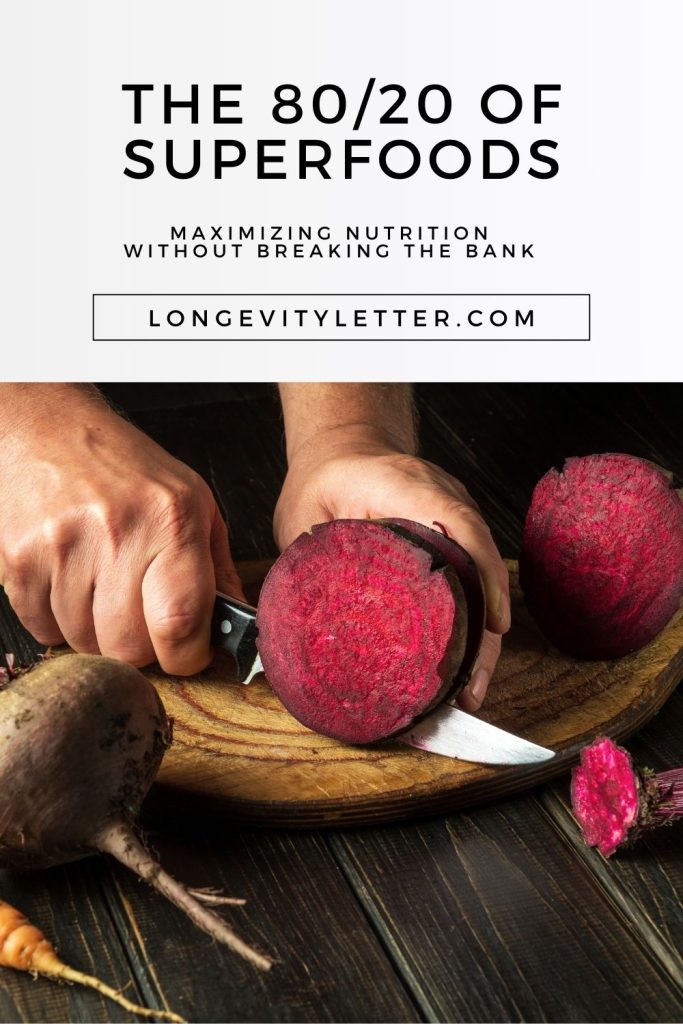If you heard of calorie restriction with optimal nutrition (CRON) for prolonging your lifespan, but you’re hesitant about restricting calories and/or you feel overwhelmed by the rising cost of groceries, then this article on the 80/20 of superfoods is for you!
Because you can always make better choices. Here are my 80/20 of superfoods which I include in my diet, especially when funds are lower than usual.
The 80/20 of Superfoods
1. Beetroot
There is never a season when beetroots are expensive, at least in my area (Eastern Europe), but they are especially appreciated during winter when I don’t have much choice in terms of seasonal vegetables. Rich in betalains, polyphenols, folate and fibers, I boil them and add them to pasta (among many other veggies) or to a potato salad.
2. Eggs
Even when funds are low, I prefer to buy free-range eggs (or eggs from hens which are allowed to roam freely on the ground) because they are likely to include more nutrients from the worms and insects those hens are likely to get. Given that eggs shouldn’t be consumed more than 2-3 times/week, the price difference is also acceptable. The ingredients which I’m most interested in are the carotenoids (lutein and zeaxanthin), omega 3 fatty acids (higher in free-range eggs), high-quality protein and vitamin D.
3. Berries (especially blueberries, blackberries and black currants)
These are not usually cheap, but I included them here because they contain lots of nutrients such as flavonoids (anthocyanins) and other polyphenols (resveratrol) and they’re low in sugar. It’s important to search for local options because the more they travel, the more nutrients they lose. I’ll either buy them during summer when they are in season or throughout the year as frozen.
4. Avocado
There are many monounsaturated fat examples, but the reason for which I included only the avocado in this 80/20 list of superfoods is that this one can mostly form a meal on its own. The fastest one I can think of is to mix slices from one ripe avocado with some pasta and some tomato sauce. By the way, the avocado is ripe when it is soft to the touch.
5. Leafy greens and especially microgreens and red cabbage
Red cabbage has more polyphenols (especially anthocyanins) than green cabbage, while microgreens include more vitamins, minerals, but fewer fibers compared to regular leafy greens. It is for this reason that I prefer to buy these two variants and add them to sandwiches, but any leafy green salad will do to increase your daily amount of nutrients.
6. Fish
Fish is rich in omega 3 acids, vitamin D, zinc, taurine, iodine, selenium and all these can modulate your aging markers and by eating smaller fish, you also diminish your risk of mercury exposure. For this reason, if I’m strapped for money, I’d rather buy fish than any other kind of meat.
Including superfoods in your diet doesn’t have to be complicated or expensive. By focusing on these six affordable and nutrient-dense superfoods, you can support your health and modulate your aging, even if you’re not restricting calories.
But if you’d like to try calorie restriction without sacrificing nutrition or flavor AND know when you shouldn’t restrict calories, check out my practical guide on calorie restriction with optimal nutrition – it’s packed with practical tips and strategies to make it sustainable and effective.
